Individual healing is an integral part of collective healing – in witnessing one another, we grow together.
Our individual healing is magnified when we share our vulnerabilities – our emotions, narrative, and experiences – in the presence of others. Our embodied witnessing enhances the healing power. Today, we have an urgent need to move away from Western paradigms based on hyper-individualism, which has been over-emphasized in the past decades. In recent years we have seen an increasing interest in collective healing, which has been fueled by our technological connectivity, which has transformed our world, when used well, into a global village. Virtual meetings enable us to create and grow social healing environments not bound by physical location, empowering us to extend our presence in non-local space/time. As we emerge in this way, our collective learning creates greater collective intimacy.
What stands in the way of moving into deeper connection with one another – as people, and as nation states – is the amount of trauma within and in between our cultures, and of course in and between us as human beings. Yet, to solve our most challenging crises – everything from war to climate to poverty – our leaders must focus on global collaboration. As citizens, we can also find ways to transcend the boundaries that perpetuate a sense of separation.
Fields of Collective Trauma

Our most precious life energy is bound up in what can be perceived as fields of collective trauma – matrices of energy that tightly hold the pain of unresolved actions of the past. The energy that fuels othering, polarization, conflicts, and recurrent, non-emergent processes is actually frozen in these fields. The true nature of this energy, once unfrozen, is creativity, innovation, and relationality. To unfreeze this frozen potential, we need an acceleration of healing outcomes, post-traumatic growth, and a broadening of our perspectives as humanity so that we can truly see and innovate.
Individual and Collective Interdependence
Without realizing it, we perceive ourselves often as separate from our environment (I am on the planet vs I am part of the planet). We also imagine that we can control our destinies and our fortunes. Of course, we contribute to our success in life, but each individual exists only as part of a network of interdependent relationships within an ecosystem. We only exist as relationships; the more flowing and open they are, the more we are in a state of well-being or health. When aspects of the relationship between the individual and the ecosystem are split off, reduced or held back, disease enters. That is why maintaining a healthy relational data flow is crucial to health.
The beauty of a collective space is that it’s a witnessing space. Many of the atrocities in the world are happening without witnesses. Victims yearn for a warm, safe space where they can finally be seen, restoring their dignity and human rights. Embodied witnessing brings together caring, seeing, and sensing. The witnessing capacity of a group is a powerful healing asset. When we work through trauma that stems from a transgression of ethics and human rights, the ethical breach and harm must surface to ultimately be integrated into the relational network and released as post-traumatic learning. Coming together, our collective intelligence assists the nervous system of the victim who is seeking healing, integrating the pain or trauma. The split off, separate, or excluded part then becomes reconnected to the web of life. For this process to unfold, collective spaces need to promote safety, warmth, authentic connection, and resonance.
Hosting the Pain of the World
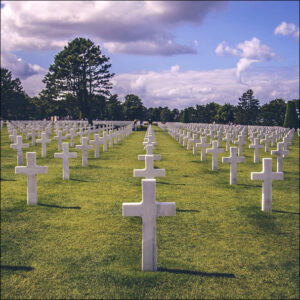
When we begin to access fields of collective trauma to begin the healing process together, we often become aware of those who have passed away, often in violent circumstances. Their presence may be palpable in the social fabric until the transgression has been re-owned by those who are living, allowing these souls to rest in peace. Often, societies try to hide or look away from this collective pain, which is why the integration process gets stuck. Looking away from the pain means we can’t be present with each other; metaphorically, we are dispersed in space and time.
When we as humanity are not fully present to what is happening now, and what has not been resolved in the past, we become obsessed with looking forward. We become hypnotized by the idea of building or getting to a better world in the future because we can’t be with the world as it is happening now. This is an important defense mechanism that helps us to not feel the pain or deal with past transgressions. However, if we don’t examine those consciously, we will stay fragmented and re-traumatization will occur. The only way we can build a better world is to build it in this world. We need to use every moment to co-create the world we wish to live in instead of wishing for it to happen tomorrow.
In a traumatized world, redemption happens later: The glance toward the future is the missing embodiment in the now, where we integrate the pain into presence to receive the blessing of the real future, the world that we download together as and in presence. True innovation always happens now.
Intellectualizing the World We Can’t Feel
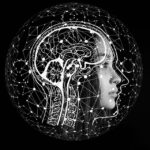
When we begin the process of collective healing, we become more attuned to the way we have inhibited the evolutionary process of life, which is caused by trauma. Trauma often inhibits the self-healing mechanism of individuals, teams, organizations, and entire cultures. We need to build the capacities to witness the fragmentation and hurt to begin to heal. That is not just an intellectual process; it’s possible to write a dissertation about a subject without having witnessed a situation or a historical fact as an embodied, whole being. Once we have an intellectual understanding we might say “but I know” and “I know that”. Knowledge is important, but if we can’t feel what we know, we are missing the essence. In fact, a common defense mechanism in response to trauma is intellectualizing our perception of the world that we can’t feel. Knowledge only becomes wisdom when we learn to embody it.
Authenticity is Life Speaking

Becoming a living prayer means that we walk our talk, that our actions align with our words, that the word and the inner state of a person are one in the same. That is a living prayer. To fully embody life, we have to explore our inner gaps between talking and living. Authenticity is life speaking; it’s the coherence between the mind, emotions, body, and the relational space of a person.
Authenticity doesn’t equal “ideal.” The ideal world that we often aspire to create may be shared as a vision with others, but it is often a defense strategy in response to trauma. This vision of the ideal gives us hope and motivation to go on, but at the same time it represents the aspects of life that we can’t feel. We need ideals to have hope, which is important for people to stabilize themselves in the lives we are living. However, this vision of the ideal country, person, organization, and future can reveal the gap between ourselves and the world we are actually living in.
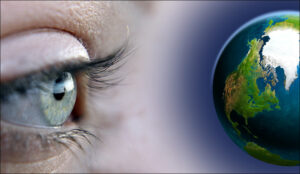
When we embrace the real world, the world as it is, we harness the powers of innovation, creativity, and radical change. Perceiving the real without filters, as we integrate trauma, becomes a catalyzing force as we move beyond the limiting constructs of the ideal. We no longer get frustrated and bitter because our good intentions don’t seem to make an impact. When we access all that is real, we come into intimate connection with what we could describe as the loving, compassionate nature of the “real”. We get in greater touch with the process of life, without shying away from the pain of the world and the dark parts of humanity. As leaders, activists, entrepreneurs, influencers, change agents, and healers, we need to learn to host the world within ourselves, not simply to fix a world “out there”. Every time we are triggered and touch our trauma, we externalize the world and project onto it; we can’t stay related and represent the world within ourselves, which is the basis of love and compassion.
Wisdom is the world that we can host in ourselves. This is love.
Love is the sole motivation which allows us to become social healers, entrepreneurs, and leaders of new innovative movements. Love is the power which allows us to care for the world. It is the foundation upon which social transformation rests. As social healers and leaders we have to examine our motivations. In doing so, we find out that what we want to change outside is what also needs to be changed inside. The more awareness we have of this, the more transformational our actions will be.
Trauma says “Here, in time and space, it’s not good for me”
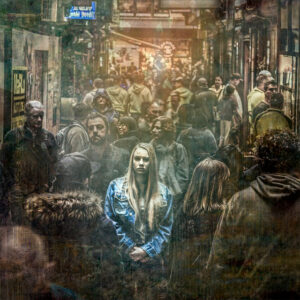
The nature of the trauma response is that it saves us from tremendous pain and overload, and it helps us to survive incredibly painful moments in our lives. This applies to our attachment process and childhood development, too. That response is intelligent; not being present in this world, not sensing the full range of experience available in our bodies, in relationships and in moments of abuse or violence is really important. Trauma says, “Here, in space and time, it’s not good for me.” However, when a freeze takes over and repetitive actions occur, it’s also important to observe that the original pain is not happening anymore. “Not being here” is a quality that is widespread in our cultures since so many people, including our ancestors who have experienced wars and other painful phases, couldn’t digest overwhelming situations.
We see this also in cultural symptoms of a community, society, or a nation. Only part of our society is happening now, the other part is a repeating loop of the past, existing in a different dimension. These non-emergent processes do not have a future until they are re-owned consciously and integrated into the flow of life. Parts of our society are perpetually stuck as hostages of the past. We can call “not here, not now” the fragmentation of space-time. Once we create a cultural awareness of this compulsion towards collective repetition manifesting as political issues, cycles of violence, inequality, racism, oppression, hegemonic structures and more, we can begin to transform the repetition into a different flow. We then release the circular, repeating quality of this cycle, which brings about an update, a new movement.
In separation, without this awareness and recognition, trauma cannot be updated.
Capacities for Social Healing
As a field of energy and movement, social healing evolves through the inner world of an individual, in the relational space between individuals, and in the “we spaces” that we create together, the collective social interior.
Individual capacities:
• Self-awareness
• 3-sync (synchronizing mind, body, emotions)
• Nervous system regulation
• Grounding and body awareness
• Willingness to track one’s own interiority and process
Relational capacities
• Willingness to hold space for each other’s painful areas
• Co-regulation between nervous systems
• Willingness to reflect oneself in other people, gain different perspectives
• Capacity to take in and evaluate feedback
• Willingness to overcome isolation and share one’s own inner process with others
WE capacities
• Being aware of the collective space
• Noticing the collective atmosphere of a group, team, organization, or culture
• Developing the capacity to be part of a “we”
• Collective, embodied witnessing
• Listening and becoming attuned to resonance as part of the “we space”
Sharing is Generous
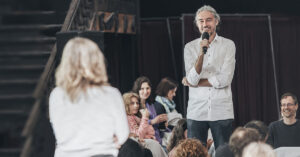
The power of sharing our inner process within a larger group is generous, and listening to someone who shares their experience freely in a group, while attuning to that person, is an act of generosity. Together, we create true generosity — the remedy for trauma which shows up as scarcity.
Collective healing spaces are the remedy to the isolation, aloneness, depression, and disorientation that many people experience. From teenagers who are isolated behind their computers to elderly people in the last phase of their lives, connection to others is the key to health. Having a healthy relational network is integral to flourishing.
A collective healing space magnetizes the shared resonance that exists in the presence of the group as people sense and attune to those who share. Sharing in this way demystifies the seemingly personal nature of the issue and allows us to see how universal our pain is, how we share the same challenges as others. When we witness this, it makes it much easier to share and experience together. The resonance with someone’s sharing gives other people the opportunity to learn more about that part in themselves.
The attention and energy that crystallizes when many people are witnessing a person’s vulnerable sharing adds tremendous awareness and healing power to that one person’s process. Healing in community is a win-win situation. Through the hyper-individualism of Western cultures we create an isolated bubble of suffering which we call our own issues. However, when we engage in collective healing in group spaces, it’s clear in the intersubjective awareness that we exist in an interconnected web of life. Everything that is aligned with collective intelligence can be integrated, healed, and will lead to greater learning and an expansion of perspective.
Social Healing Rituals
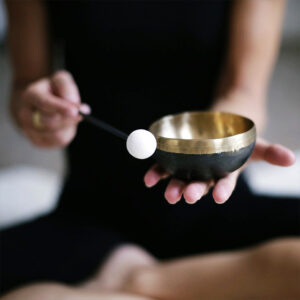
We elevate our capacity for collective healing when we create holding spaces that allow for re-owning our cultural and historical legacies. Within the complexity needed for profound cultural change today, this is not just an option, it’s a necessity. This work is critical if we take public health seriously. The trauma repetition in our world creates persistent suffering and health issues which we need to end. And we can do this. We need to appeal to our philanthropists and other funders to support the development of collective healing spaces where skilled facilitators can help support a trauma integration process. We are the ones who can change and restore the past. We don’t have to continue with domestic violence, abuse, racist behaviors or structural violence; we don’t have to continue with human trafficking and sex slavery, with creating billionaire kings and devastating poverty around the world. We don’t have to continue with any of this, because we know how to stop this vicious cycle.
It’s time to change, because we know that we can.
Social healing rituals require the formation of safe spaces that provide:
• An intention
• A relational, communal space
• The capacity to work with the collective trauma of the culture
• Relational skills of mutual exploration and co-regulation
• The willingness to explore the painful aspects of our cultural past
• Capacity learn from one other
• A space to integrate the painful past and to explore how that helps us to change our lives today
Thomas Hübl / Lori Shridhare
